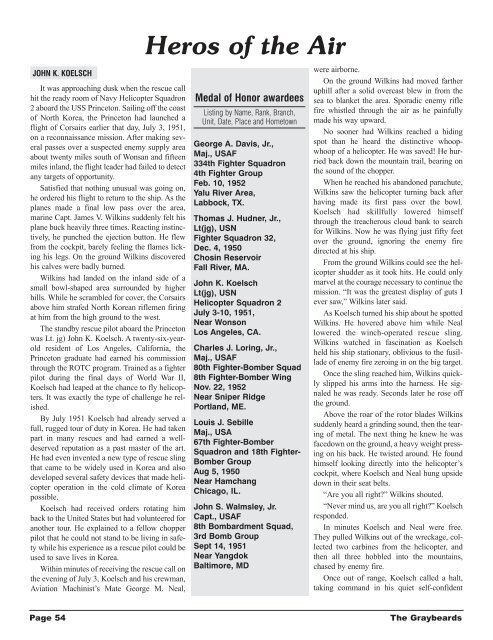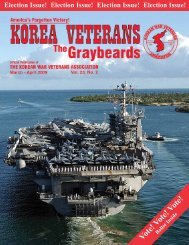The Graybeards - Korean War Veterans Association
The Graybeards - Korean War Veterans Association
The Graybeards - Korean War Veterans Association
Create successful ePaper yourself
Turn your PDF publications into a flip-book with our unique Google optimized e-Paper software.
JOHN K. KOELSCH<br />
It was approaching dusk when the rescue call<br />
hit the ready room of Navy Helicopter Squadron<br />
2 aboard the USS Princeton. Sailing off the coast<br />
of North Korea, the Princeton had launched a<br />
flight of Corsairs earlier that day, July 3, 1951,<br />
on a reconnaissance mission. After making several<br />
passes over a suspected enemy supply area<br />
about twenty miles south of Wonsan and fifteen<br />
miles inland, the flight leader had failed to detect<br />
any targets of opportunity.<br />
Satisfied that nothing unusual was going on,<br />
he ordered his flight to return to the ship. As the<br />
planes made a final low pass over the area,<br />
marine Capt. James V. Wilkins suddenly felt his<br />
plane buck heavily three times. Reacting instinctively,<br />
he punched the ejection button. He flew<br />
from the cockpit, barely feeling the flames licking<br />
his legs. On the ground Wilkins discovered<br />
his calves were badly burned.<br />
Wilkins had landed on the inland side of a<br />
small bowl-shaped area surrounded by higher<br />
hills. While he scrambled for cover, the Corsairs<br />
above him strafed North <strong>Korean</strong> riflemen firing<br />
at him from the high ground to the west.<br />
<strong>The</strong> standby rescue pilot aboard the Princeton<br />
was Lt. jg) John K. Koelsch. A twenty-six-yearold<br />
resident of Los Angeles, California, the<br />
Princeton graduate had earned his commission<br />
through the ROTC program. Trained as a fighter<br />
pilot during the final days of World <strong>War</strong> II,<br />
Koelsch had leaped at the chance to fly helicopters.<br />
It was exactly the type of challenge he relished.<br />
By July 1951 Koelsch had already served a<br />
full, rugged tour of duty in Korea. He had taken<br />
part in many rescues and had earned a welldeserved<br />
reputation as a past master of the art.<br />
He had even invented a new type of rescue sling<br />
that came to be widely used in Korea and also<br />
developed several safety devices that made helicopter<br />
operation in the cold climate of Korea<br />
possible.<br />
Koelsch had received orders rotating him<br />
back to the United States but had volunteered for<br />
another tour. He explained to a fellow chopper<br />
pilot that he could not stand to be living in safety<br />
while his experience as a rescue pilot could be<br />
used to save lives in Korea.<br />
Within minutes of receiving the rescue call on<br />
the evening of July 3, Koelsch and his crewman,<br />
Aviation Machinist’s Mate George M. Neal,<br />
Heros of the Air<br />
Medal of Honor awardees<br />
Listing by Name, Rank, Branch,<br />
Unit, Date, Place and Hometown<br />
George A. Davis, Jr.,<br />
Maj., USAF<br />
334th Fighter Squadron<br />
4th Fighter Group<br />
Feb. 10, 1952<br />
Yalu River Area,<br />
Labbock, TX.<br />
Thomas J. Hudner, Jr.,<br />
Lt(jg), USN<br />
Fighter Squadron 32,<br />
Dec. 4, 1950<br />
Chosin Reservoir<br />
Fall River, MA.<br />
John K. Koelsch<br />
Lt(jg), USN<br />
Helicopter Squadron 2<br />
July 3-10, 1951,<br />
Near Wonson<br />
Los Angeles, CA.<br />
Charles J. Loring, Jr.,<br />
Maj., USAF<br />
80th Fighter-Bomber Squad<br />
8th Fighter-Bomber Wing<br />
Nov. 22, 1952<br />
Near Sniper Ridge<br />
Portland, ME.<br />
Louis J. Sebille<br />
Maj., USA<br />
67th Fighter-Bomber<br />
Squadron and 18th Fighter-<br />
Bomber Group<br />
Aug 5, 1950<br />
Near Hamchang<br />
Chicago, IL.<br />
John S. Walmsley, Jr.<br />
Capt., USAF<br />
8th Bombardment Squad,<br />
3rd Bomb Group<br />
Sept 14, 1951<br />
Near Yangdok<br />
Baltimore, MD<br />
were airborne.<br />
On the ground Wilkins had moved farther<br />
uphill after a solid overcast blew in from the<br />
sea to blanket the area. Sporadic enemy rifle<br />
fire whistled through the air as he painfully<br />
made his way upward.<br />
No sooner had Wilkins reached a hiding<br />
spot than he heard the distinctive whoopwhoop<br />
of a helicopter. He was saved! He hurried<br />
back down the mountain trail, bearing on<br />
the sound of the chopper.<br />
When he reached his abandoned parachute,<br />
Wilkins saw the helicopter turning back after<br />
having made its first pass over the bowl.<br />
Koelsch had skillfully lowered himself<br />
through the treacherous cloud bank to search<br />
for Wilkins. Now he was flying just fifty feet<br />
over the ground, ignoring the enemy fire<br />
directed at his ship.<br />
From the ground Wilkins could see the helicopter<br />
shudder as it took hits. He could only<br />
marvel at the courage necessary to continue the<br />
mission. “It was the greatest display of guts I<br />
ever saw,” Wilkins later said.<br />
As Koelsch turned his ship about he spotted<br />
Wilkins. He hovered above him while Neal<br />
lowered the winch-operated rescue sling.<br />
Wilkins watched in fascination as Koelsch<br />
held his ship stationary, oblivious to the fusillade<br />
of enemy fire zeroing in on the big target.<br />
Once the sling reached him, Wilkins quickly<br />
slipped his arms into the harness. He signaled<br />
he was ready. Seconds later he rose off<br />
the ground.<br />
Above the roar of the rotor blades Wilkins<br />
suddenly heard a grinding sound, then the tearing<br />
of metal. <strong>The</strong> next thing he knew he was<br />
facedown on the ground, a heavy weight pressing<br />
on his back. He twisted around. He found<br />
himself looking directly into the helicopter’s<br />
cockpit, where Koelsch and Neal hung upside<br />
down in their seat belts.<br />
“Are you all right?” Wilkins shouted.<br />
“Never mind us, are you all right?” Koelsch<br />
responded.<br />
In minutes Koelsch and Neal were free.<br />
<strong>The</strong>y pulled Wilkins out of the wreckage, collected<br />
two carbines from the helicopter, and<br />
then all three hobbled into the mountains,<br />
chased by enemy fire.<br />
Once out of range, Koelsch called a halt,<br />
taking command in his quiet self-confident<br />
Page 54 <strong>The</strong> <strong>Graybeards</strong>

















